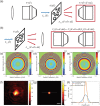Optical imaging featuring both long working distance and high spatial resolution by correcting the aberration of a large aperture lens
- PMID: 29907794
- PMCID: PMC6003919
- DOI: 10.1038/s41598-018-27289-1
Optical imaging featuring both long working distance and high spatial resolution by correcting the aberration of a large aperture lens
Abstract
High-resolution optical imaging within thick objects has been a challenging task due to the short working distance of conventional high numerical aperture (NA) objective lenses. Lenses with a large physical diameter and thus a large aperture, such as microscope condenser lenses, can feature both a large NA and a long working distance. However, such lenses suffer from strong aberrations. To overcome this problem, we present a method to correct the aberrations of a transmission-mode imaging system that is composed of two condensers. The proposed method separately identifies and corrects aberrations of illumination and collection lenses of up to 1.2 NA by iteratively optimizing the total intensity of the synthetic aperture images in the forward and phase-conjugation processes. At a source wavelength of 785 nm, we demonstrated a spatial resolution of 372 nm at extremely long working distances of up to 1.6 mm, an order of magnitude improvement in comparison to conventional objective lenses. Our method of converting microscope condensers to high-quality objectives may facilitate increases in the imaging depths of super-resolution and expansion microscopes.
Conflict of interest statement
The authors declare no competing interests.
Figures






Similar articles
-
Optical system design of double-sided telecentric microscope with high numerical aperture and long working distance.Opt Express. 2023 Jul 3;31(14):23518-23532. doi: 10.1364/OE.496322. Opt Express. 2023. PMID: 37475433
-
High numerical aperture Fourier ptychography: principle, implementation and characterization.Opt Express. 2015 Feb 9;23(3):3472-91. doi: 10.1364/OE.23.003472. Opt Express. 2015. PMID: 25836203 Free PMC article.
-
Super-resolution microscopy with very large working distance by means of distributed aperture illumination.Sci Rep. 2017 Jun 16;7(1):3685. doi: 10.1038/s41598-017-03743-4. Sci Rep. 2017. PMID: 28623362 Free PMC article.
-
Variable immersion microscopy with a high numerical aperture.Opt Lett. 2021 Feb 15;46(4):856-859. doi: 10.1364/OL.416006. Opt Lett. 2021. PMID: 33577531
-
A versatile high resolution objective for imaging quantum gases.Opt Express. 2013 Apr 8;21(7):9011-6. doi: 10.1364/OE.21.009011. Opt Express. 2013. PMID: 23571991
Cited by
-
Increasing the Beam Width and Intensity with Refraction Power Effect Using a Combination of Beam Mirrors and Concave Mirrors for Surgical-Fluorescence-Emission-Guided Cancer Monitoring Method.Sensors (Basel). 2024 Aug 25;24(17):5503. doi: 10.3390/s24175503. Sensors (Basel). 2024. PMID: 39275414 Free PMC article.
-
A practical guide to light-sheet microscopy for nanoscale imaging: Looking beyond the cell.J Appl Phys. 2024 Sep 7;136(9):091101. doi: 10.1063/5.0218262. Epub 2024 Sep 4. J Appl Phys. 2024. PMID: 39247785 Free PMC article.
-
Laser scanning reflection-matrix microscopy for aberration-free imaging through intact mouse skull.Nat Commun. 2020 Nov 12;11(1):5721. doi: 10.1038/s41467-020-19550-x. Nat Commun. 2020. PMID: 33184297 Free PMC article.
-
Imaging actin organisation and dynamics in 3D.J Cell Sci. 2024 Jan 15;137(2):jcs261389. doi: 10.1242/jcs.261389. Epub 2024 Jan 18. J Cell Sci. 2024. PMID: 38236161 Free PMC article.
References
-
- Hell, S. W. & Wichmann, J. Breaking the diffraction resolution limit by stimulated emission: stimulated-emission-depletion fluorescence microscopy. Optics Letters19 (1994). - PubMed
Publication types
LinkOut - more resources
Full Text Sources
Other Literature Sources

